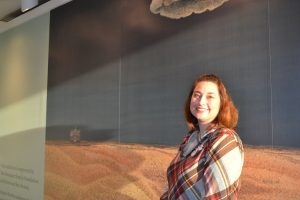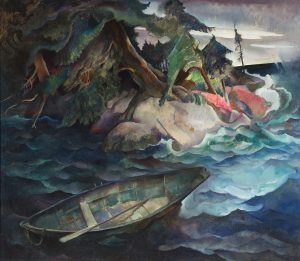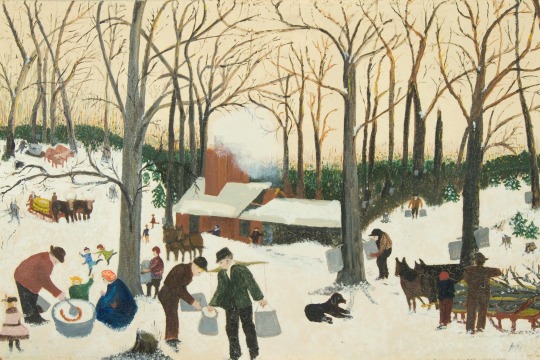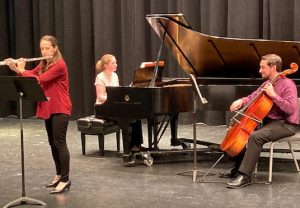An ambitious exhibition replete with surprises opened at the Brandywine River Museum of Art this past weekend, providing insight into a vivid time period of artistic experimentation in America.

Called “Rural Modern: American Art Beyond the City,” the show, which runs through Jan. 22, focuses on avant-garde art from the 1920s through the 1940s. The works were created by well-known artists who took the modernist styles flourishing in urban hubs like New York, Boston and Chicago to rural regions – ranging from small-town Pennsylvania to Midwestern farms to coastal New England.
The exhibit includes nearly 70 paintings by renowned painters such as Charles Demuth, Arthur Dove, Marsden Hartley, Anna Mary Robertson “Grandma” Moses, Georgia O’Keeffe, Charles Sheeler, Horace Pippin, Grant Wood, Andrew Wyeth, and N.C. Wyeth. Many offer a glimpse into styles and interpretations not readily associated with their creators.
For example, two O’Keefe paintings –“Lake George – Autumn” and “Barn with Snow” – differ dramatically from her distinctive Southwest and floral paintings. They were done in the 1920s when she spent time at Lake George in upstate New York.
“Rural Modern provides a fascinating new examination of some of the 20th century’s best-known American artists who left the city behind and found subjects not usually associated with modernism,” said Thomas Padon, director of the Brandywine River Museum of Art.
The genesis of the show came from its curator, Amanda C. Burdan, who said she found herself intrigued by the way in which modernism transferred to different areas of the country during a dynamic period in American history. The fact that N.C. Wyeth played a pivotal role in that transfer fueled her research. Her journey to illustrate the connections eventually went “from sea to shining sea” as she arranged to borrow all but five of the works in the show.
The paintings came from 37 lenders, a variety of museums as well as private collections, Burdan said. In some instances, she needed all of her powers of persuasion to make the loans happen. One of her more successful arguments centered on the fact that some of the paintings, such as Demuth’s “Buildings Abstraction, Lancaster” were returning to their roots.

The exhibition is divided into three sections. “Rural Modern Landscape” features sweeping vistas and the architecture of rural America while “Rural Modern Life” section showcases the denizens of that terrain: from farmers to fishermen to lumberjacks. And “Rural Modern Gothic” depicts a darker edge to an America beset by the environmental woes of industrialization and the economic crisis of the Depression.
In addition to providing a colorful view of American history between the two world wars, the exhibit also offers a travelogue of interesting personalities from the workers in “Bringing in the Maple Sugar” by Grandma Moses to the buyer and seller depicted in Grant Wood’s “Appraisal,” a work painted a year after Wood’s famously iconic “American Gothic.”
Area visitors are likely to recognize some of the local scenes represented in the exhibit. The Lukens Steel mill provided inspiration for Ralston Crawford in “Steel Foundry” as well as Demuth’s “End of the Parade.” And a 23-year-old Andrew Wyeth illustrated the encroachment of progress in a painting called “Road Cut,” which shows the intrusion of Ring Road.
An even younger Wyeth offers a different kind of startling contrast in “Ridge Church.” His painting of a 19th-century church in Martinsville, Maine, when he was 19, hangs alongside a painting of the same church by his father and teacher, N.C. Wyeth. In fact, Burdan said the pair worked on the paintings simultaneously. Displayed next to the younger Wyeth’s work is a photograph that shows him with his easel in front of the building, believed to have been taken by his father.

Although the two works differ greatly in style and approach, Burdan said the juxtaposition attests to the senior Wyeth’s interest in teaching his son to be true to himself, not imitate his tutor. In a letter written shortly before Andrew Wyeth finished the painting, his father enthused: “Andy’s Glenmere church is superb!”
On a more somber note, N.C. Wyeth’s “The Drowning,” shows an empty dory that appears to be defying gravity in rough seas. Wyeth painted the work as a tribute to Douglas Anderson, the 16-year-old son of family friends in Port Clyde, Maine. The teen disappeared while lobster fishing in 1935; his body was found months later.
Visitors will have numerous opportunities to learn more about the paintings through a series of special events and lectures. For more information, visit http://www.brandywine.org/museum.
Following its run in Chadds Ford, the exhibition, which received support from The Davenport Family Foundation and Morris and Boo Stroud, will travel to the High Museum in Atlanta, which collaborated on the exhibit. At the Atlanta museum, which is about four times the size of the Brandywine, the exhibit will be expanded to include murals and photography. With a new name – “Cross Country: The Power of Place in American Art, 1915-1950” – it will be on view from Feb. 12 through May 12.
The Brandywine River Museum of Art is open daily (except Thanksgiving Day and Christmas Day) from 9:30 a.m. to 5 p.m. Admission is $15 for adults, $10 for seniors ages 65 and over, $6 for students and children ages 6 to 12; and free for children 5 and younger and members. It located on Route 1 in Chadds Ford; for more information, call 610-388-2700 or visit brandywinemuseum.org.



Comments